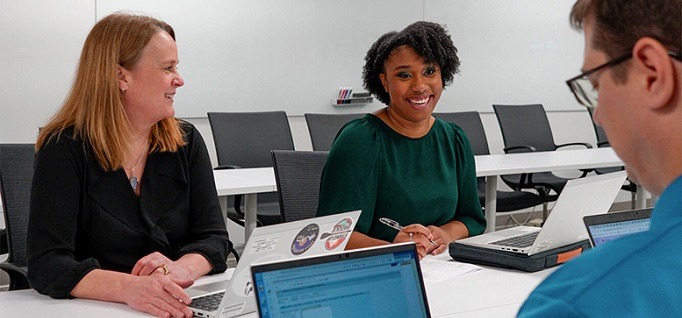Indiana leans into youth apprenticeships
By David Tobenkin
March 13, 2024
An ambitious statewide youth apprenticeship program modeled on the renowned Swiss system of apprenticeships starting in high school is being developed in Indiana, with Ivy Tech Community College (Ivy Tech), the statewide community college system, playing an important role.
If successful, it could be a gamechanger in labor participation rates and how employers and educators in the state try to steer students toward career-education pathways that benefit Hoosier students, educators and employers alike. It could also serve as a model for other states, some of which are working on similar apprenticeship systems.
The results of a related Indiana youth apprenticeship pilot program, as well as those of similar programs elsewhere in the country, some underway for more than a decade, demonstrate that successful U.S. youth apprenticeship programs can be developed. Still, they also show that there are many challenges to scaling them up to a size where their employment, educational and societal impacts would rival those produced by apprenticeship programs in European leaders like Switzerland and Germany.
An aspiring endeavor
In January, the Richard M. Fairbanks Foundation, Ascend Indiana and the Indy Chamber announced that a coalition of Indiana employers, educators, state officials and other stakeholders would participate in an Implementation Lab (referred to as an iLab) facilitated by youth apprenticeship experts from the Center on Economics and Management of Education and Training Systems (CEMETS) at ETH Zurich, a Swiss public research university. The group announced that the coalition intended to develop a comprehensive, statewide plan over the subsequent 10-month period to scale the number of available modern youth apprenticeships in three industry groupings that are facing labor shortages in Indiana – banking and insurance, life sciences and healthcare, and advanced manufacturing.
Participating students will receive a high school diploma, college credit, an industry credential and skills in in-demand careers. In particular, the program will target many Hoosier high school students who never ultimately graduate with a higher education degree.
What is perhaps most remarkable about iLab is its scope. The statewide coalition includes more than 100 members organized into various committees, including a governing committee; an industry committee of key employers; a committee of state and private economic development partners; a high school committee; and a higher education committee.
Ivy Tech, with 19 campuses and 177,115 students served in 2022-23, is a major player in those efforts, notes Ivy Tech President Sue Ellspermann, who is co-chair of the iLab higher education committee.
“At Ivy Tech, part of our mission is to be Indiana’s workforce engine,” Ellspermann says. “The number one challenge of employers, particularly for emerging industries, is to have a skilled workforce. This program seems a very natural and great way to develop workforce talent. We, our state leaders, and [foundation supporters] have studied apprenticeships with this Swiss model for more than five years and we believe the time is right. We’re going to engage all Hoosiers in those bright future apprenticeships the way the Swiss do the model, where there are no dead ends and there is a permeable progression for career paths and postsecondary education.”
That effort remains a work in progress as participants work through the many complexities of determining who will do what under the effort, notes Claire Fiddian-Green, president and CEO of the Richard M. Fairbanks Foundation (Fairbanks Foundation) and iLab co-chair.
The next major step in iLab will occur sometime in the summer when a strategic plan for the roll-out of the program is announced, Fiddian-Green says.
What are Swiss-style youth apprenticeships?
Like many higher education institutions, and community colleges in particular, Ivy Tech for decades has offered a variety of apprenticeships for adult students, mainly concentrated in the building and industrial trades and mainly administered by unions and other trade guilds. More than 10,000 students are in apprenticeship programs at any time, with 8,000 in union-led programs and 1,000 more in industry-led apprenticeship, says Molly Dodge, Ivy Tech’s senior vice president of workforce and careers.
The new Swiss-style apprenticeships, often more generically called modern youth apprenticeships, however, are a different and distinct model. Such programs:
- Usually commence with high school, rather than college, but often extend after high school graduation.
- Involve longer and more intense commitments by students to employers, frequently three or more years.
- Rely upon establishing industry-wide standards for apprenticeships, rather than companies setting up their own bespoke programs, which improves transferability of skills and economic mobility.
- Involve greater employer direction of supporting education.
- Tend to involve a wider range of apprenticeship fields, with many focused on high-labor force demand fields.
The challenges of scaling
Not all elements of the Swiss model can, or necessarily should, be emulated for a U.S. program to be successful, say many interviewed. Given state variations, the model must be adapted to what works in particular states and even sub-state regions, notes Gretchen Morgan, a Colorado-based managing partner of the Center for Innovation in Education, a non-profit that examines educational policy frameworks. Morgan authored a 2019 study for the Manhattan Institute that examined the Swiss apprenticeship model and its applicability to the U.S. education and employment landscape.
Morgan says the Indiana state-wide comprehensive approach of taking time to work through stakeholder needs, interests and concerns is promising, given the need for different stakeholders to find sufficient value in apprenticeships and find ways to align educational and employment components not originally designed to work together to accommodate apprenticeship programs.
“Stakeholders need to find genuine and even selfish reasons to collaborate and make adjustments to how they usually do business in service of a greater positive,” Morgan says.
There’s more to the story! Read the full article in CC Daily.



